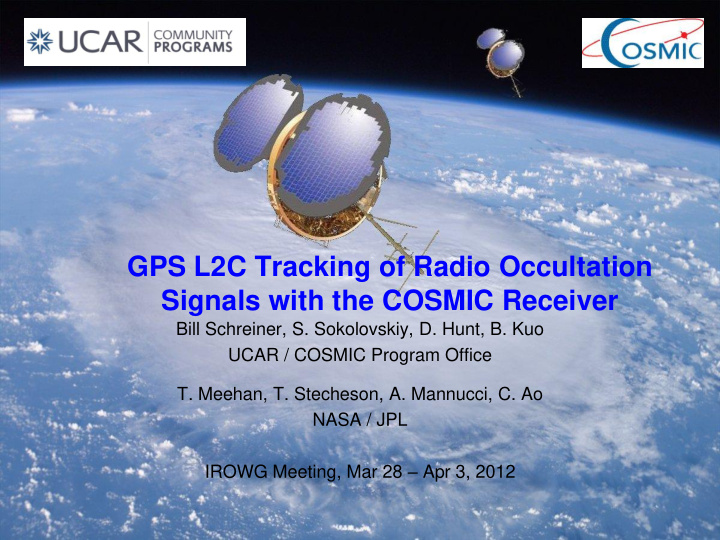



GPS L2C Tracking of Radio Occultation Signals with the COSMIC Receiver Bill Schreiner, S. Sokolovskiy, D. Hunt, B. Kuo UCAR / COSMIC Program Office T. Meehan, T. Stecheson, A. Mannucci, C. Ao NASA / JPL IROWG Meeting, Mar 28 – Apr 3, 2012
Upper stratosphere and lower troposphere are regions of maximum uncertainty for GPS RO inversions at what height to start using signal for inversion ? In the lower troposphere: In the upper stratosphere: the signal reduces below noise level the signal reduces below noise level in terms of the amplitude in terms of the phase (Doppler)
Benefits of L2C Tracking • Improves L2 SNR • Reduces BA noise in the stratosphere • Use of L2 down to lower heights for ionospheric correction • L2C Phase-Lock Loop tracking may allow significant reduction of errors due to diffractional effects for occultations affected by the ionospheric scintillation • Combined use of L1CA and L2C Open-Loop signals may reduce impact of noise in lower troposphere inversions
Estimation of Bending Angle Noise Histograms of STDV between 60 - 80 km 2012.001-068 L2C results in lower noise of the bending angles (important for inversions in the stratosphere) L2P (rad) L2C Interval for Statistical comparison of COSMIC noise estimation to ECMWF in the stratosphere (60 – 80 km)
Truncation of L2 Signal Determination of L2 cut-off altitude 1) Mean deviation 1 Hz Dop c f L 2 Dop f L 1 2) Fluctuations 6 Hz Dop f L 2 Dop f L 2 Ionospheric calibration below cut-off L 1 L 2 Extrapolation of difference iono free L 1 C L 1 L 2 denotes mean
L2 Truncation with COSMIC Since Jan 2012, COSMIC receivers are configured to track L2C (setting occultations) Statistical Comparison Higher stability to fluctuations with ECMWF L2C can be used down to lower heights than L2P (L2P often fails at sharp tropopause) L2 Cut-off Altitude vs Latitude L2P L2C L2C less noisy than L2P L2P ~ 18% fail QC L2C ~ 3% fail QC
Examples of ionospheric scintillation on L1CA and L2C signals scintillation sporadic E-clouds
Back propagation of RO signals In case of localized ionospheric irregularities, the regions with minimum fluctuation of BP amplitude correspond to the regions with minimum diffractional effects on complex signals. BA should be calculated in these regions.
BA from RO signals calculated - Directly and - After back propagation of complex signals to the regions of minimum fluctuation of amplitude
Combining L1CA and L2C BA in the lower troposphere by use of the amplitude of WO transform - largest BA spikes correspond to regions of small amplitude
Combined BA is less responsive to noise on RO signal
Summary • JPL implemented L2C tracking on COSMIC – Operational ~ Jan 2012 • L2C data reduces BA noise in the stratosphere • L2C allows use of L2 signal down to lower heights for ionospheric correction • L2C Phase-Lock Loop tracking allows significant reduction of errors due to diffractional effects for some example occultations affected by the ionospheric scintillation. Statistical comparisons next. • Combined use of L1CA and L2C Open-Loop signals reduces impact of noise in some example lower troposphere inversions. Statistical comparisons next. 12
Acknowledgments • NSF • Taiwan’s NSPO • NASA/JPL, NOAA, USAF, ONR, NRL • Broad Reach Engineering
Recommend
More recommend